Professional teeth whitening
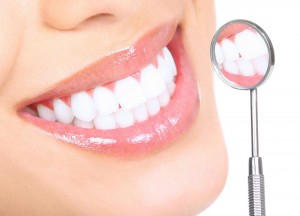
Teeth whitening in dentistry is usually divided into mechanical and chemical.
By mechanical lightening is meant the removal of soft and hard plaque from the surface of the teeth.
Mechanical whitening is carried out using ultrasonic treatment with polished teeth and the Air Flow method.
The chemical method of whitening is to brighten teeth using hydrogen peroxide or urea.
Moreover, using these substances, both home and professional teeth whitening are possible.
- When bleaching at home, the patient conducts all the procedures on his own using special kits, gels, whitening strips, and pencils.
- Teeth whitening in the dentist's office is a safer procedure.
Dental discoloration can occur for several reasons:
- Hard tooth tissue consists of two layers: dentin, top coated with translucent enamel. With age, the enamel becomes thinner and the dentin, shining through the enamel, gives the teeth a yellowish tint. In addition, dentin itself becomes darker throughout life.
- Another significant reason for discoloration of teeth relates to a person having such a bad habit as smoking.
- Enamel darkening can also be caused by the abuse of products that can stain teeth: red wine, coffee, tea, berries, carbonated drinks, herbal decoctions, etc.
- The teeth become dull and turn gray after depulpation.
- As a result of careless filling of the root canals, traces of blood may remain on their walls. As a result, the teeth may become bluish.
When teeth whitening is not recommended
Professional teeth whitening is effective in approximately 90% of patients. As a rule, yellowed teeth respond better to whitening, and darkened with a gray or brown tint do not whiten well enough.
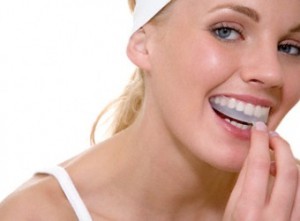
Professional whitening is not performed in the following cases:
- During pregnancy and during breastfeeding.
- Persons under the age of 16.
- If there is an increased sensitivity of the teeth. When bleaching enamel is prone to thinning, and therefore will lead to a deterioration.
- In the presence of fillings, veneers, crowns, whitening will be ineffective. Only natural teeth lend themselves to lightening. If there is a filling or veneer, the tooth color will differ from the restoration, and it will become more noticeable.
- If the teeth are bluish in color as a result of a violation of the technology of filling the canals. In this situation, tooth whitening using compositions based on hydrogen peroxide is impossible.
- Teeth with a brown or gray tint whiten very weakly.
Kinds
There are several options for professional whitening:
- Zoom technology.
- Laser teeth whitening.
- The use of professional teeth-brightening products at home.
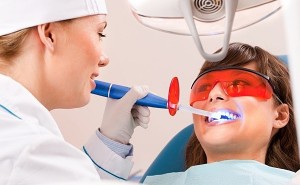
Gel and mouth guards are used for laser and zoom teeth whitening, and light and heat sources are additionally attracted. The need to use the latter is due to the manufacturing technology of the bleaching composition by its manufacturer.
Features
- Getting the best result compared to home whitening.
- Used products containing high% hydrogen peroxide, in comparison with the gels used at home.
- Fast and visible result in one go. The procedure lasts no more than an hour.
- High cost of the procedure.
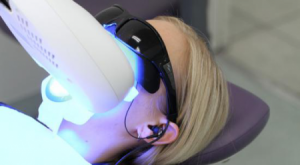
How is
- At the first stage, professional cleaning of the teeth from dental plaque is carried out.
- Immediately before the procedure, hygienic brushing of the teeth is carried out in order to remove surface contaminants so that the active components can freely penetrate deep into the enamel.
- The teeth are isolated from the soft tissues of the cheeks and lips.
- A special protective agent is applied to the edge of the gums to prevent gel from entering.
- On the front surface of the teeth falling into the smile zone, a whitening gel is applied.
- The teeth are exposed to a curing lamp or laser. As a result, the components of the whitening agent are activated. In some cases, you may need to repeat the procedure.
- At the end of the exposure, the teeth are cleaned of the remnants of the gel by rinsing the mouth.
- A fluorine-containing preparation is applied to the enamel in order to prevent the formation of increased tooth sensitivity, which appears after the whitening procedure.
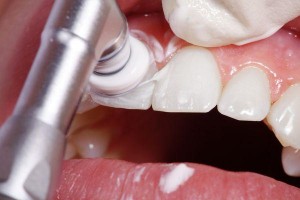
Side effect
Professional whitening is a safe procedure, but nevertheless it can have certain side effects:
- The presence of increased tooth sensitivity, which manifests itself either immediately after the procedure (with a single whitening), or during the passage of the enamel whitening course (with whitening for several procedures).
- Irritation of soft tissues as a result of a burn of the mucous membrane with components of a whitening gel. A complication may be gum disease, accompanied by bleeding and even necrosis.
- When exposing the roots of the teeth there is a great risk of damaging their surface, which will subsequently lead to tooth decay.
- Obtaining undesirable results is possible with the use of low-quality bleaching agents, in the presence of crowns, veneers or fillings that are not amenable to bleaching. After the procedure, such restorations will become noticeable against the background of real teeth.
Cost
| Way | Prices (in rubles) |
| Rembrandt Plus Whitening Paste (tube) | 550 |
| Crest 3D White Whitestrips Strips for Home Whitening | 2100 |
| Homemade Opalescence (USA) gel and mouthguard whitening | 4800 |
| Zoom whitening | from 10000 |
Reviews
- Before bleaching teeth passed examination. It turned out that the enamel is quite sensitive. I chose the most delicate way to brighten teeth. She bleached her teeth with ultrasound. The teeth became smooth and turned white in several tones. This did not affect the increase in sensitivity.
- He bleached his teeth with a laser. I expected that the sensitivity of the teeth would increase, but I did not feel any discomfort either after the procedure or in the future. The result was excellent.
- My teeth were yellow due to smoking. In dentistry, offered photobleaching. The procedure was carried out in three stages for an hour. I was satisfied with the result. Plaque and yellowness completely disappeared. But the dentist warned that if I continued to smoke, I would often have to whiten my teeth.
Video: “Teeth Whitening - Popular Dentistry”